Bergen, North Holland
| Bergen | |||
|---|---|---|---|
| Municipality | |||
|
Egmond aan Zee town centre | |||
| |||
.svg.png) Location in North Holland | |||
| Coordinates: 52°40′N 4°43′E / 52.667°N 4.717°ECoordinates: 52°40′N 4°43′E / 52.667°N 4.717°E | |||
| Country | Netherlands | ||
| Province | North Holland | ||
| Government[1] | |||
| • Body | Municipal council | ||
| • Mayor | Hetty Hafkamp (GL) | ||
| Area[2] | |||
| • Total | 119.46 km2 (46.12 sq mi) | ||
| • Land | 97.10 km2 (37.49 sq mi) | ||
| • Water | 22.36 km2 (8.63 sq mi) | ||
| Elevation[3] | 1 m (3 ft) | ||
| Population (May 2014)[4] | |||
| • Total | 29,987 | ||
| • Density | 309/km2 (800/sq mi) | ||
| Demonym(s) | Bergenaar | ||
| Time zone | CET (UTC+1) | ||
| • Summer (DST) | CEST (UTC+2) | ||
| Postcode | 1860–1873, 1930–1935 | ||
| Area code | 072 | ||
| Website |
www | ||
Bergen (![]() pronunciation ) is a municipality and a town in the Netherlands, in the province of North Holland. Its North Sea beaches make it a popular destination for tourists. In 2001, the municipality was formed from a merger of the former municipalities of Egmond, Schoorl, and the smaller community of Bergen proper that had existed since 1811.
pronunciation ) is a municipality and a town in the Netherlands, in the province of North Holland. Its North Sea beaches make it a popular destination for tourists. In 2001, the municipality was formed from a merger of the former municipalities of Egmond, Schoorl, and the smaller community of Bergen proper that had existed since 1811.
Since about 1900, Bergen has been the home of many painters, writers and architects. Some of the work of this "Bergen School" is on exhibit at Museum Kranenburgh. The neighbourhood of Park Meerwijk, constructed in 1915, is made up entirely of villas in Amsterdam School style. There are regular art fairs in Bergen, as well as an annual music festival (the Holland Music Sessions in August) and arts festival (the Kunsttiendaagse in October).
North of the town of Bergen are the Schoorlse Duinen, a nature area with the highest and widest dunes of the Netherlands, which reach about 59m (195 ft) above sealevel, and are more than 5 km (3.1 mi) wide in some places.
Other points of interest in the municipality include the aquarium in the seaside village of Bergen aan Zee, the Auto Union Museum in Bergen with a collection of classic cars, and the historical museums Het Sterkenhuis (Bergen) and Museum van Egmond (Egmond aan Zee).
The town of Bergen is home to the European School, Bergen.
Population centres

The municipality of Bergen consists of the following towns, villages and/or districts: Bergen, Aagtdorp, Bergen aan Zee, Bregtdorp, Camperduin, Catrijp, Egmond aan den Hoef, Egmond aan Zee, Egmond-Binnen, Groet, Hargen, Rinnegom, Schoorl, Schoorldam (partly), Wimmenum.
History

The Egmond Abbey, founded in the 10th century, became the most important cultural center of medieval Holland. The abbey was protected by the House of Egmond, which eventually became a powerful noble family. The three towns of Egmond have been mentioned since the 10th century as well. Both the Egmond Abbey and Castle of Egmond in Egmond aan den Hoef were destroyed in 1573 on order of William the Silent during the Dutch Revolt.
The town of Bergen developed around a chapel and is mentioned as far back as the tenth century as well. An old local legend is the "Miracle of Bergen", which is said to have occurred during the St. Elisabeth's Flood of 1421. The story goes that the schout (sheriff) of Bergen found a chest containing hosts (the thin wafers used in Holy Communion) from the church of Petten which had floated to Bergen during the flood. The seawater that penetrated the chest had turned into blood. There is also a second miracle story, thought to have occurred in 1422, whereby hosts turned into blood. On the site where the miracle of Bergen is said to have happened, a chapel was erected. Bergen became a place of pilgrimage and Roman-Catholic processions were held at the site for centuries and are still ongoing today.
In the fifteenth century, the Ruïnekerk ("Ruined Church") was built on the site of the chapel and at the time was the largest of its kind in the province of North-Holland. In 1574, during the Eighty Years War against Spain, the church was looted and burned down by Dutch Protestants, but was later rebuilt to its current state.
In 1799, during the French Revolutionary Wars, a British-Russian army invaded North-Holland. At Bergen, a battle with the French-Batavian armies took place on 19 September. The Russisch Monument in Bergen commemorates this Battle of Bergen.
Bergen was one of the main stations on the narrow gauge railway between Alkmaar and Bergen aan Zee, which ran between 1905 and 1955. One of the locomotives which operated on this line, 'Bello' stood for many years in the town centre as a memorial, and is now preserved at the Museumstoomtram Hoorn - Medemblik.
Local government
The municipal council of Bergen consists of 23 seats, which are divided as follows:
- VVD - 3 seats
- CDA - 3 seats
- Gem Bel B.E.S. - 3 seats
- PvdA - 2 seats
- D66 - 3 seats
- GroenLinks - 3 seats
- KIES Lokaal - 6 seats
People born in Bergen
- Pierre Golle (1620-1684) - cabinetmaker and designer
- Simeon ten Holt (b. 1923) - composer
- Saskia Noort (b. 1967) - writer and journalist
- Kees van Wonderen (b. 1969) - footballer
- Jim Bakkum (b. 1987) - singer and actor
References
- ↑ "Mevr Hetty Hafkamp" [Mrs. Hetty Hafkamp] (in Dutch). Gemeente Bergen. Retrieved 24 February 2014.
- ↑ "Kerncijfers wijken en buurten" [Key figures for neighbourhoods]. CBS Statline (in Dutch). CBS. 2 July 2013. Retrieved 12 March 2014.
- ↑ "Postcodetool for 1861KG". Actueel Hoogtebestand Nederland (in Dutch). Het Waterschapshuis. Retrieved 24 February 2014.
- ↑ "Bevolkingsontwikkeling; regio per maand" [Population growth; regions per month]. CBS Statline (in Dutch). CBS. 26 June 2014. Retrieved 24 July 2014.
External links
 Media related to Bergen, North Holland at Wikimedia Commons
Media related to Bergen, North Holland at Wikimedia Commons Bergen, North Holland travel guide from Wikivoyage
Bergen, North Holland travel guide from Wikivoyage- Official website
 |
Schagen |  | ||
| North Sea | |
Langedijk Alkmaar Heiloo | ||
| ||||
| | ||||
| Castricum |

_vlag.svg.png)
